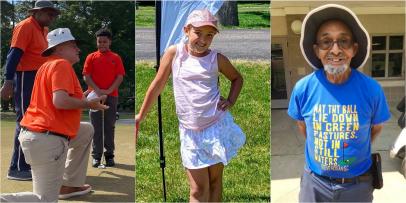gd honors
Welcome to the first edition of the Golf Digest Honors

From our magazine’s founding in 1950 to our multiple-channel brand today, we’ve always celebrated the very best, from the astonishing feats of professionals to the altruistic acts of average golfers and vice versa. Golf is magical because the people who pay to play often do things that are just as compelling as the people who are paid to play. Of our 10 “on-course” honors looking back at the past season, only three were won by tour pros. As for our eight “off-course” honors for golfers who give back, Rory McIlroy quite deservedly becomes the 16th winner of The Arnie, the highest honor Golf Digest bestows, but several less boldface names prove you need not be a great golfer to be great. As we look ahead to next year, we want to hear from you. Keep us apprised of incredible accomplishments at your club by filing nominations at golfdigest.com/honors. For now, join us in celebrating the 2024 class of Golf Digest Honorees. They have the tee. —Max Adler
BEST ROUND
AT STAKE: RAYMOND FLOYD’S COURSE RECORD
When financial advisor Matt DeVito tapped in a six-inch putt on 16 at the National Golf Links of America in early September to keep the round of his life going, one of his playing partners asked, “Is that seven birdies?” Their caddie shot back: “Nope. Nine.”
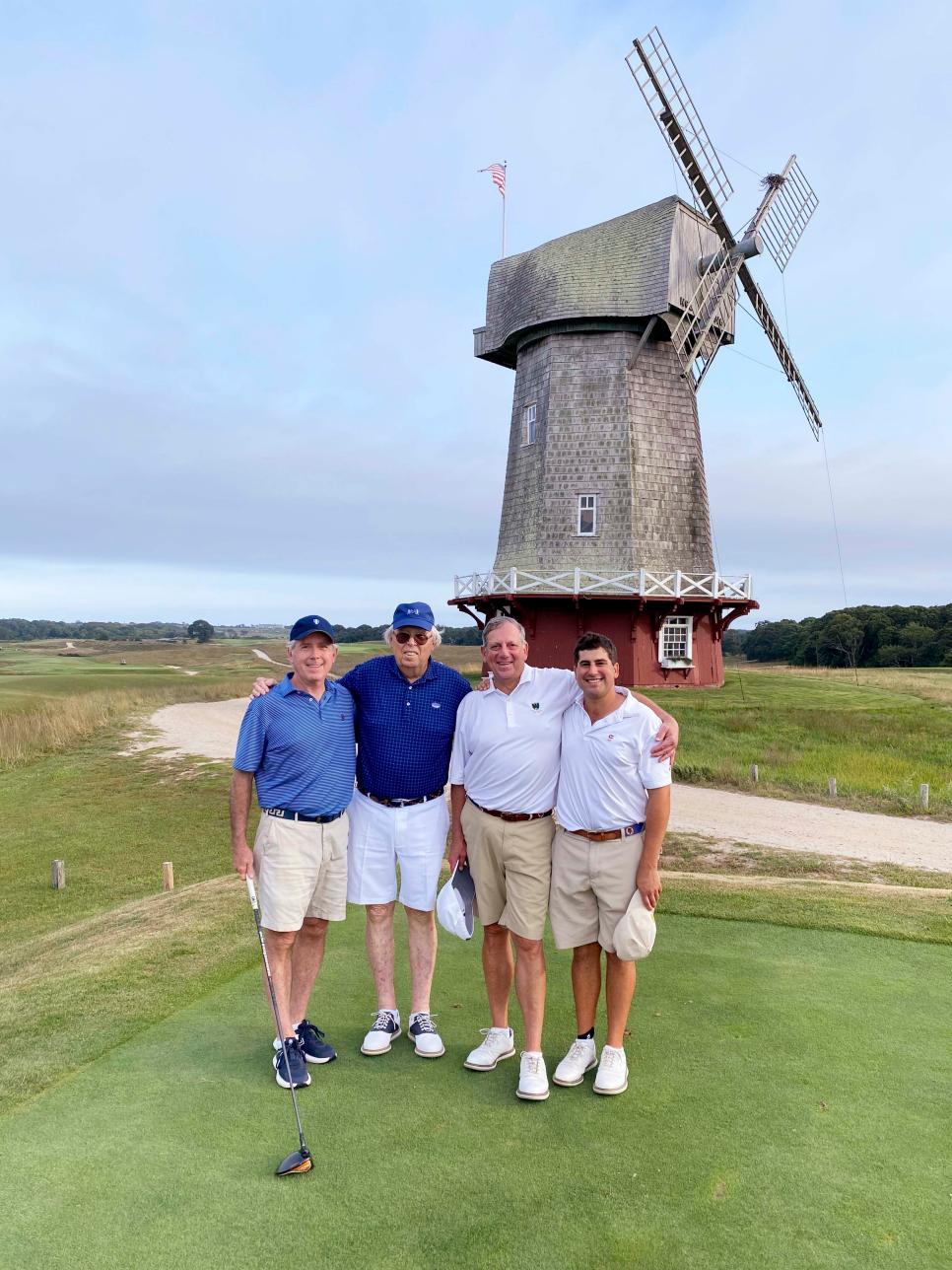
Blake and John O’Neill and Michael and Matt DeVito. Photograph courtesy of Getty Images
DeVito, a plus-2.5 handicap from Verona, N.J., didn’t play college golf but has notable competitive accomplishments, including making match play at the 2021 U.S. Mid-Amateur. On this day he was playing with his dad as guests of John O’Neill and his son, Blake. The group was mostly just enjoying the walk, but after DeVito’s kick-in at No. 16, things got real. Off to the side, Blake whispered to his father, “What’s the course record?” John knew: “It’s 62. Birdie-birdie to tie.”
DeVito’s 12-footer on 17 burned the edge, so he went to the final hole, a 502-yard par 5, needing a 3 to match Raymond Floyd’s 62 from 1997. After a good drive, he flushed a hybrid from 225, uphill to the blind green, leaving 20 feet for eagle. Just hit a good putt, DeVito told himself standing over the ball. He did—dead-center, 10-under 62.
John dashed to the shop to report the round only to find out that Floyd’s 62 was 11 under par, when the course was par 73, though DeVito had played from tees about 100 yards longer. “I wasn’t worried about [the course-record debate] at all,” DeVito says. “We had an amazing day, and we sat on the back porch with a few Southsides watching the sun set over Peconic Bay. It felt unreal.”
How unreal? DeVito hit 16 greens, had nine one-putts and made one bogey when his approach on 12 spun off the green. By all accounts, he never broke a sweat over the famous Charles Blair (C.B.) Macdonald layout, ranked No. 7 on America’s 100 Greatest Golf Courses.

Three weeks later, Matt and his wife, Heather, welcomed their first child. They named him Christopher Blair DeVito.
“My wife wouldn’t go for Charles,” he says, and then with a little smile, “but I call him C.B.” —Peter Morrice

BEST PUTT
THE ‘LAG’ THAT ENDED A COUNTRY’S 69-YEAR DROUGHT

Nick Taylor and caddie Dave Markle rejoice.
Minas Panagiotakis
For the history it made, for the wild emotions it generated, for the pride in an entire country it stirred—and, oh, yes, the distance it covered—there will never be another putt like Canadian Nick Taylor’s to capture his country’s national open on a rainy June Sunday in Toronto. To convert a 72-foot eagle putt on the fourth playoff hole in any PGA Tour event creates an indelible memory, but Taylor’s feat set off a wild celebration. Fans stormed the 18th green at Oakdale Golf & Country Club, and in a moment of confusion a security officer tackled tour pro and fellow Canadian Adam Hadwin as he was about to spray Taylor with champagne.
A Canadian NHL team hasn’t won the Stanley Cup since 1993, and this was Taylor, 35, ending a far longer source of national consternation in becoming the first native to seize the Canadian Open in 69 years.
As for the putt itself, Taylor left in the flagstick, adorned with the red-and-white maple leaf Canadian flag, and admitted he was simply trying to cozy it up to the hole for a potential birdie that would tie him with Tommy Fleetwood, who had 12 feet for his own birdie. “We knew about the last 15 feet because I had that in the second playoff hole,” Taylor said. “With the rain coming down, the slope obviously, we knew it was going to be slow. It’s so easy to leave that putt 10 feet short from how far I was.”
The 72-foot putt is the longest Taylor has made in his career. It took seven seconds from his putter face to the bottom of the cup. The memories will last for generations. —Tod Leonard
BEST ACE
A SON REPEATS THE FEAT OF HIS LATE FATHER
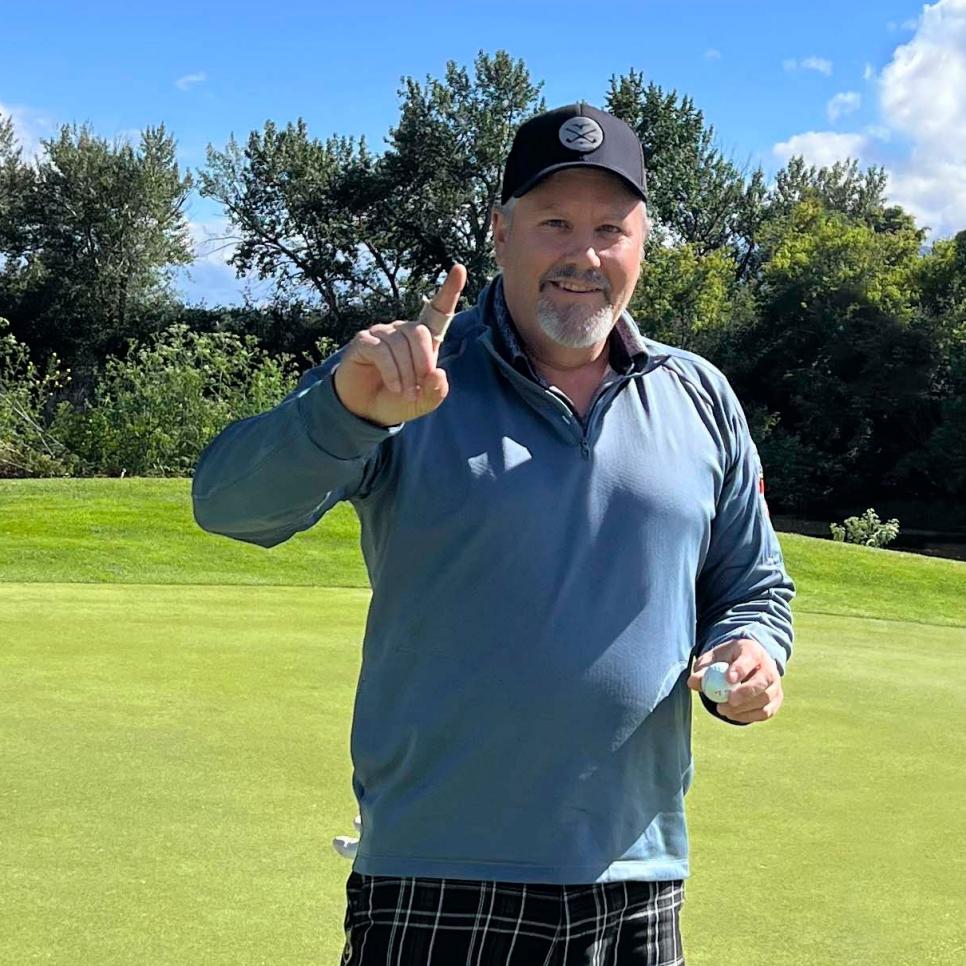
Brett Gilman: This one’s for you, Dad.
We will all leave things behind when we go. Bill Gilman, an avid golfer who was still shooting his age at 77 in 2019 when he died of cancer, left behind a few dozen Pro V1s with his initials on them. His son, Brett, kept them. On Father’s Day 2023, Brett joined his brother-in-law and nephew at his father’s old hang, Missoula Country Club in Montana. Brett had moved to Missoula in May 2018 to be closer to his family, and he got to play a lot of golf with his dad before he passed away.
For that round on Father’s Day, Brett put a sleeve of those ProV1s in play. Brett, a former superintendent who doesn’t get to the course much anymore, wasn’t playing to his 12-handicap and hadn’t hit many good shots by the time he reached the par-3 17th. “I hit a 7-iron, and, I mean, it was just one of those swings where you don’t feel the ball hit the club,” Gilman says.
It looked good, but from the elevated tee box, he couldn’t be sure of the distance. “My brother-in-law and nephew are shouting, ‘Go in the hole!’ ” The ball landed just left of the pin, took one hop forward, spun back and disappeared.
It was Gilman’s first hole-in-one, but it wasn’t the first time a Gilman had made one there. Bill Gilman made two aces in his life, one of them on No. 17 at Missoula. —Keely Levins
BEST PAR
AN IMPROBABLE SAVE AFTER GOING O.B.

Stuart Franklin
It happened during the opening round at the Omega European Masters in August, on the 292-yard seventh hole at Switzerland’s spectacular Golf Club Crans-sur-Sierre. Trying to ride a wind off the right, French professional Victor Perez instead flared his 3-wood tee shot 30 yards right of a boundary fence and into an adjacent field. “[Going out-of-bounds] was literally the only thing I could do to mess up a pretty simple hole. Now I’m thinking, Hitting 3, don’t make a 6.”
Perez, 31, who lives in Edinburgh, Scotland, promptly re-teed and smoked the next one, with the original intended high draw, the ball landing on the front of the green and feeding toward the cup—same guy, same club. “Like they say, second team All-American on my second ball,” Perez quips. He rolled in the three-footer. Best par of his life? “Absolutely, 100 percent.”
But it wasn’t Perez’s most incredible recovery. As a junior golfer playing in an event in Miami, he once dunked a tee shot into a water hazard on another short par 4, then teed up again and drove it into the cup for a birdie. —PM
BEST MATCH
A KNOCK-DOWN, DRAG-OUT BATTLE AT THE U.S. AMATEUR

John Marshall Butler (above, left) and Paul Chang dueled in the dark at the U.S. Amateur. Photographs by Kathryn Riley
Understandably, there were loose shots in the round of 16 at the U.S. Amateur at Cherry Hills Country Club. Anyone playing had won his match that morning, and staying hydrated in the August Colorado heat is a contest itself. Paul Chang, a University of Virginia golfer who had improbably walked on varsity after dominating the club scene, won his afternoon 13th hole with a desultory double bogey over Auburn golfer John Marshall Butler’s triple in which neither incurred a penalty stroke. It was the doldrum before the drama.
Butler birdied 14 to draw level. Chang’s near-perfect bid at the par-3 15th ricocheted nastily off the flagstick, but he got up and down to halve. On his next approach, a pitching wedge from 148, Chang jarred it for eagle. Butler birdied 17 to draw square. With the honor on 18, Butler hit 3-wood: “one of the most solidly struck shots I’ve ever hit.” Every driver in previous rounds had been short of the water but alas . . . “Taking the drop, I still felt I was in control of the match,” Butler recalls. He hit a gap wedge from 130 to three feet. In the near darkness, he needed all the light emanating from the clubhouse windows to convert the par. “We both had our A-plus games,” Chang says, and both accepted neither would sleep well with adrenalin still coursing. The match resumed at dawn but not the magic. Butler won the sudden-death 19th hole with a standard par. —MA
MOST CLUTCH
A BUZZER-BEATER FOR A WALK-OFF VICTORY
Stephen Curry is the all-time NBA leader in three-point field goals, with more than 3,400 converted from behind the arc. Making 3s in golf? Curry will say that getting the ball in the cup is more challenging, but not being afraid of the big moment apparently transcends all arenas.
At the 2023 American Century Championship at Edgewood Tahoe, Curry made an ace earlier in the week. When he arrived at the lakeside 18th green on Sunday before a huge and rowdy gallery, he needed to make his 18-foot eagle putt for six points to overtake tennis player Mardy Fish in the Stableford format. Setting the scene, on-course reporter Roger Maltbie observed, “Steph’s got a shot at a buzzerbeater here. Time’s running off the clock. Time to put up a shot.” The putt, rolling with perfect speed and aim, hit nothing but the bottom of the cup, setting off a wild celebration, with boat horns honking as Curry sprinted to slap hands with the gallery and hug everybody on the green. “M-V-P!” chanted the Northern California fans so familiar with Curry’s heroics.
Already a four-time NBA champion, Curry became the first Black winner of the American Century and the first active athlete to prevail since 2000. “I don’t do this for a living, so it’s something you dream about,” Curry said. Big dreams, big rewards. —TL
BEST GESTURE
A DECISION THAT ENDED A CHANCE TO PLAY IN A U.S. OPEN

Integrity makes golf special, says Tommy Kuhl.
Michael Reaves
Tommy Kuhl’s dream of playing in a U.S. Open was starting to feel real. The fifth-year senior at the University of Illinois had just shot the round of his life—a course-record 62 at a U.S. Open local qualifier in May that would send him on to final sectional qualifying. Kuhl had gone low even though the greens at Illini Country Club in Springfield were recently aerated.
Afterward, while following roommate Adrien Dumont de Chassart in a playoff for one of the final qualifying spots, Kuhl mentioned how large the aeration holes were to teammate Jackson Buchanan. “Yeah, it was difficult because you couldn’t fix them,” Buchanan said. Kuhl’s heart sank. “At that moment, I can’t even describe the feeling,” Kuhl says now. That’s because Kuhl had repeatedly repaired aeration holes during his round. Kuhl informed an official and was told what his gut already knew: Fixing the aeration marks was a breach of Rule 13.1c(2), which allows for the repair of almost any damage on the putting green except for aeration holes and natural imperfections. Just like that, Kuhl was disqualified.
“It’s like, you play well, you’ve advanced to final qualifying and are that much closer to playing in a major championship.” Kuhl could have stayed quiet or complained that there should have been a local rule to allow for repairing the holes, but that’s not how he was raised and not how he and his teammates were coached by legendary Illinois golf coach Mike Small. “Honesty and integrity, that’s what’s so special about golf,” Kuhl says. “It’s a weird situation with how it unfolded, but I tell people, rules are rules. If I’m going to play golf for a living, I should know them.” Kuhl has status on the PGA Tour Americas for 2024 but is focused on making it through Korn Ferry Tour Q school. —Christopher Powers
MOST DEDICATED
LOGGING 400 ROUNDS A YEAR FOR MORE THAN A DECADE
As the owner of a pharmacy in Mandan, N.D., Bob Gustafson has enjoyed leeway when it comes to setting his schedule. “I would work odd hours in the back office so that I had time to golf,” says Gustafson, who estimates he has played at least 400 rounds a year for more than a decade. “Golf kind of takes over your life. You’re always trying to figure out your next round.”
Figuring out when to play became much easier midway through 2023 when Gustafson sold the store and retired at age 60. That, along with a second home in Phoenix, put him close to 650 full rounds this year—all of which he dutifully entered for his USGA Handicap Index that fluctuates between 7 and 10. Gustafson played about a quarter of those rounds with his wife, Lynn, mostly at Mountain Brook Golf Club in Gold Canyon, Ariz., and Apple Creek Country Club in Bismarck, where he has the perfect setup.
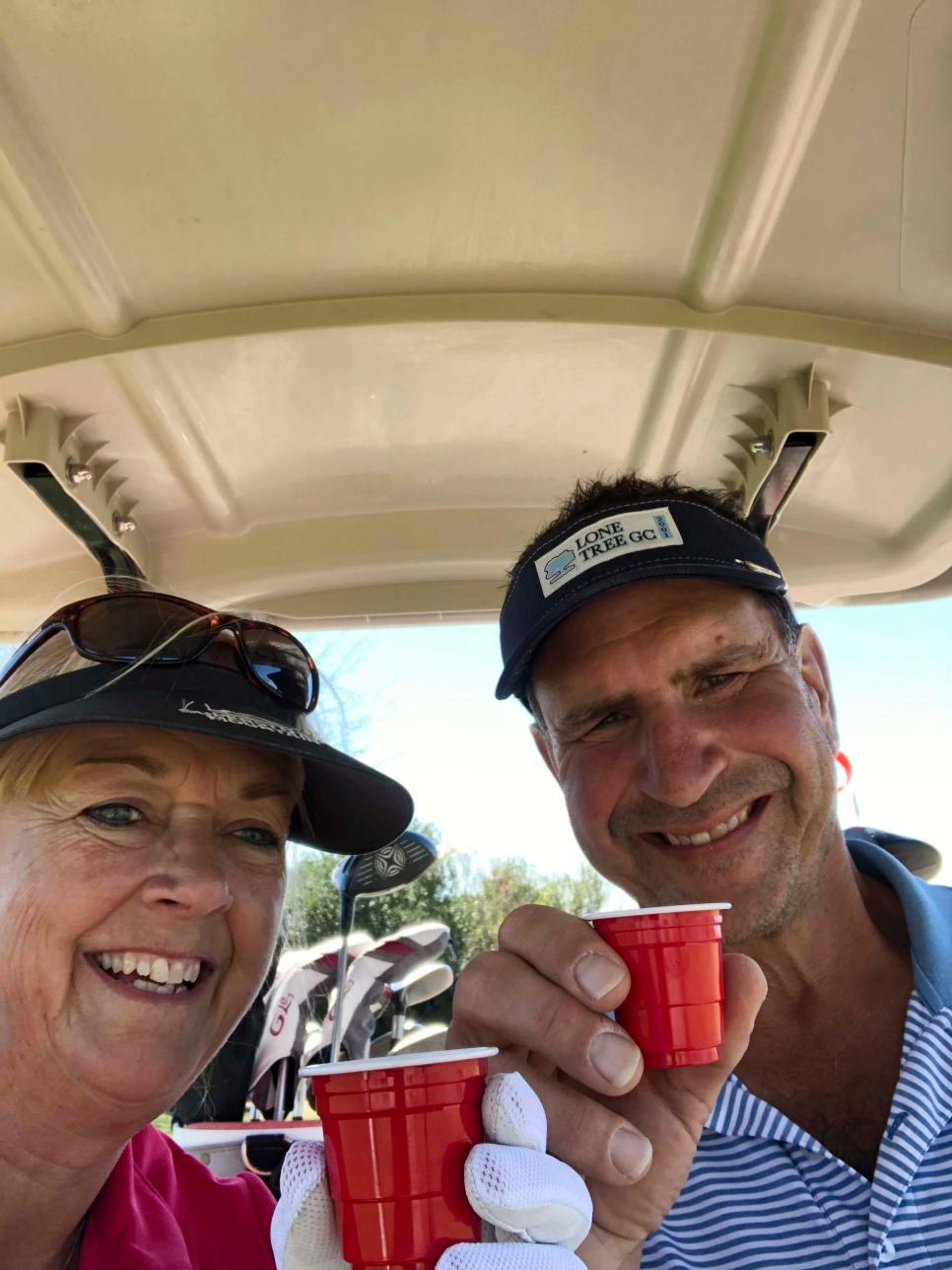
The Gustafsons toast their never-ending tour. Photograph courtesy of Bob Gustafson
“Our house is a five-minute walk to the clubhouse,” says Gustafson, who also enjoys playing with the couple’s two sons, Alex and Ryan. “I play so much that they let me take one of the carts home.”
Unlike record-breaking avid golfers we’ve featured in Golf Digest, like Barry Gibbons and Nolan Krentz, Gustafson doesn’t have a target number of rounds. “Whatever happens, happens,” he says. “I just play when I want to play.” —Alex Myers
MOST IMPROVED
HOW DATA TRANSFORMED THIS 18-HANDICAPPER
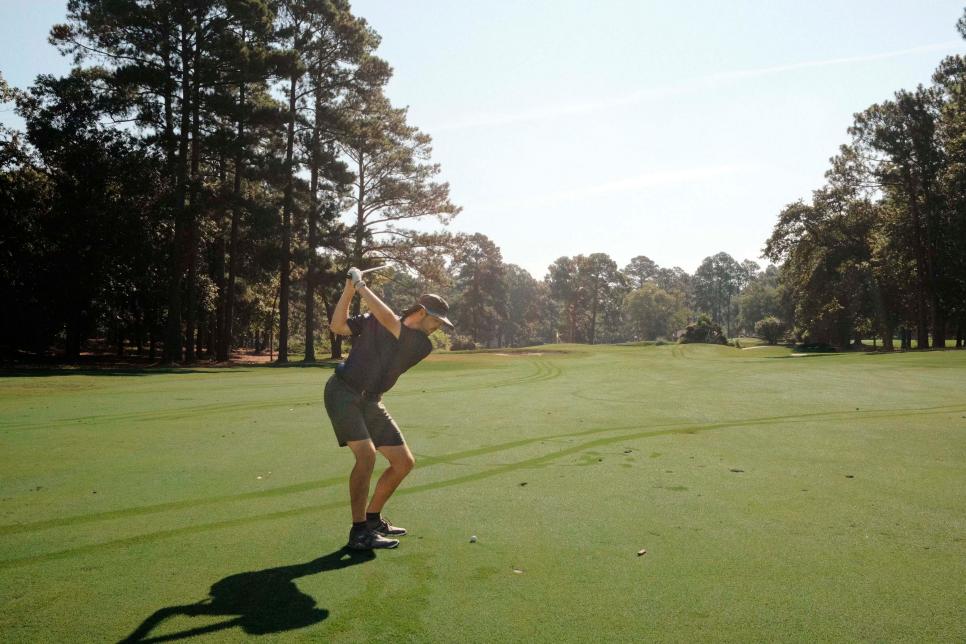
James Kinsey III cracked the code to improvement. Photograph courtesy of James Kinsey III
Any golfer concerned about how getting married might affect his golf game can find inspiration in James Kinsey III, a 33-year-old wealth manager from Columbia, S.C. After tying the knot in 2022, Kinsey had an incredible golf season in 2023, dropping from an 18-handicap to as low as a 6.6 Index. Kinsey credits the swing tips of his regular golf buddy, Tyler Forbes, a former assistant pro, and a golf-focused physical assessment under the watch of former Georgia Tech men’s golf coach Puggy Blackmon. Blackmon showed the 6-foot-4, 200-pound Kinsey that he wasn’t using the ground enough to maximize power.
“That was sort of the mental kickstart I needed,” says the former high school baseball player. “That showed me my potential.” It was about this time that Kinsey started using Arccos technology to track his performance, leading him to practice more from certain distances under 100 yards. “The data shows where you need to put in more work, and then you get to see if the practice is paying off,” says Kinsey, who tries to play and practice one to two times per week at the WildeWood Club and has bought a putting mat for home. “The data helped me to stay interested and hungry to improve.” —Alex Myers
BEST BOUNCEBACK
THE ULTIMATE GUT CHECK FOR A FIVE-TIME MAJOR CHAMP
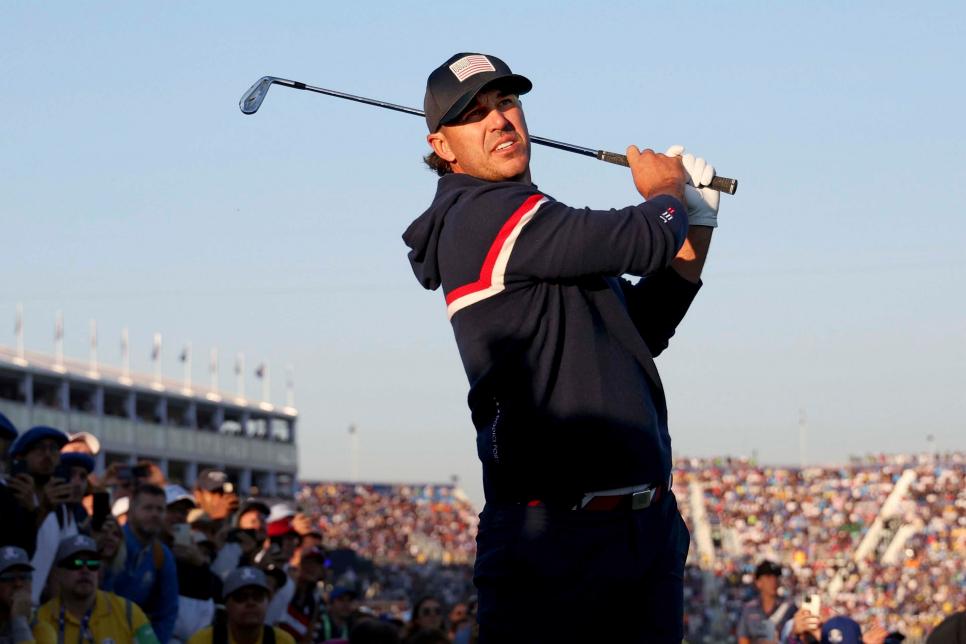
Brooks Koepka displayed impressive grit.
Jamie Squire
To some, five-time major champion Brooks Koepka can come across as brash and self-important, but Koepka is, above all, a winner. Look back to the 2023 Ryder Cup at Marco Simone Golf Club. The Europeans swept the opening foursomes, and the U.S. team went winless in the afternoon courtesy of a bitter blow from Jon Rahm, who holed a 33-foot eagle putt to halve a match with partner Nicolai Hojgaard against World No. 1 Scottie Scheffler and Koepka.
The next morning, Scheffler and Koepka took on the Nordic duo of Viktor Hovland and rookie Ludvig Aberg. At the turn, the match was already a funeral procession. Facing a 34-foot bogey putt on the short par-4 11th, the U.S. pair conceded the hole, etching their names to a 9-and-7 loss that is the largest defeat in Ryder Cup history.
Scheffler, shortly after, burst into tears on the sidelines. Koepka quickly disappeared into the clubhouse for the remainder of the day. Even the European crowd celebrated mutely in the wake of such humiliation.
As fate had it, Koepka was drawn against Aberg in Sunday singles, a rematch that for many players would have come agonizingly too soon.
Brooks seized the opening hole of the day, then won the sixth and the eighth. Aberg won just two holes all day, and Koepka won both back within two holes. Koepka was six under par when he closed out Aberg, 3 and 2, the U.S. team’s biggest victory of the day.
A matchup that could have been a devastating second blow to many players’ confidence proved for Koepka the ultimate bounce back. —Luke Kerr-Dineen
.jpg.rend.hgtvcom.406.271.suffix/1704304024249.jpeg)
